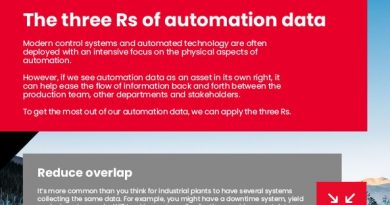Obsolescence in pharma automation
Despite the life sciences being an industry where precision and quality is vital, pharmaceutical companies have been slow to upgrade their process control automation systems. Here, Sean Robinson, service leader at Novotek UK and Ireland, explains why, as many paper-under-glass data handling systems begin reaching obsolescence, it is time for pharmaceutical companies to upgrade their process control automation without affecting FDA/EU compliance.
Broadly speaking, pharma companies have made little progress in modernising their data collection practices. This is largely due to fears that changes in data handling will affect compliance with regulations laid out by the Food and Drug Administration (FDA) or EU governing bodies. Modernisation, through the increased flexibility and efficiency it can bring, can better equip companies to face increased competitive pressures from patent extinction on flagship products, allow more rapid scaling of product and packaging variants, and help address the increasing presence of counterfeit products.
The evolution of Good Manufacturing Practices (GMP – later with an added A for Automated) has been critical in developing and maintaining consumer trust in pharmaceutical products. In practice, though, it has led to conservatism in the way processes are developed and launched, and rigidity in the way data is collected in relation to production activities. The last generational rollout of automation in the pharma sector occurred during the early 2000s, and saw the entrenchment of minimalist approaches to use of tracking systems alongside core automation. While other industries adopted plant IT systems that made extensive use of automated data flows to support performance analysis and continuous improvement efforts, life sciences companies effectively reproduced their old paper tracking systems in electronic format.
Such ”paper-under-glass” systems have tended to be very limited in functional scope and often address only digitising the logging of data directly needed to provide batch reporting supporting the release of product into the marketplace. To this day, many pharmaceutical companies are reluctant to update their paper-under-glass approach due to a misconception that any data collected automatically effectively becomes part of their official batch record regimen, and must therefore be managed in strict accordance with regulations such as the US FDA’s 21 CFR Part 11. While regulators (the FDA in particular) have gone to great lengths to clarify the way such regulations should be interpreted, this initial confusion has had a lasting effect.
Electronic Signature Regulations (ESRs) such as 21 CFR Part 11 outline the requirements for a combination of secure system configuration capabilities, data logging/transactional auditing capabilities and physical data security management. These rules are in place to allow companies to record data with fidelity and prevent data being lost.
What is misunderstood here is that data not needed for the batch record does not need to comply to ESRs. Therefore, managing records related to understanding performance improvement opportunities related to manufacturing assets and processes does not need to be complex and time-consuming.
Paper-under-glass also often leads to ineffective evaluation of batch quality because the detail in electronic batch records is inadequate to run root cause analysis of quality issues that arise. In the event of a machine breaking down, paper-under-glass systems will not give useful insight into what has caused the malfunction, and companies lose productivity. By limiting the footprint of what data is collected automatically, pharma companies deprive themselves of the rich detailed asset data that would correlate to asset events such as downtime, or to quality events where the underlying issue may be driven by a combination of asset health information, process execution information and material characteristic information. While a paper-under-glass system may help log what is happening, easy access to these additional data sets is crucial to quickly understanding the “why”.
Fortunately, pharmaceutical manufacturers today have clearer insight than they did two decades ago into how automated systems can comply with ESRs and GAMPs. Now, with many of these systems due to be approaching obsolescence in the coming years, it’s time for pharmaceutical businesses to consider how they can adopt automation and plant IT that supports improvements in all aspects of production without impacting regulatory compliance.
Novotek’s experience in the sector has shown that there can be a number of ways to deploy solutions ranging from SCADA systems with batch execution footprints; to Historians; to manufacturing execution systems. For each of these there are well-understood approaches where the configuration ensures that compliance critical data can be logged in appropriately controlled ways, while easing the collection of separate data for root cause and improvement analysis. Best-in-class pharmaceutical companies typically leverage a suite of solutions providing the mix of execution support, track and track and detailed end-to-end visibility into the production process and assets. From that, the mix of capabilities extends to include:
- Eased proof of quality and compliance
Faster and deeper understanding of root causes of quality events and productivity losses
Simpler deployment of anticounterfeiting measures (as the mix of modern IT and automation solutions open up better methods than some of the bolt-ons built around now-obsolete automation and ERP platforms)
Greater adaptability of production lines to run a broader range of qualified products
As conditions in the life sciences marketplace become tougher for producers, we at Novotek believe that there is an opportunity for firms to rethink the role of production technology – to see it as a source of competitive advantage. And the generational change in systems now underway due to obsolescence means now is the time for pharmaceutical businesses to seize that advantage.



